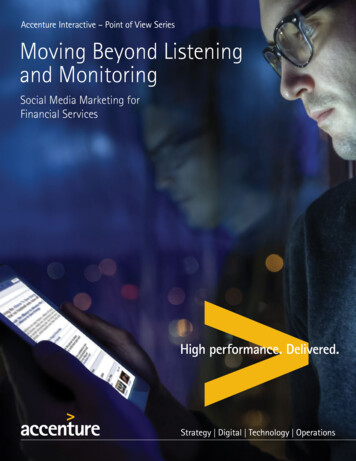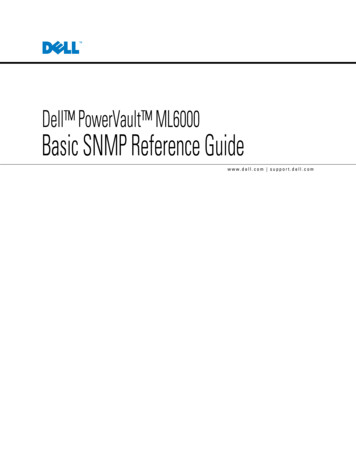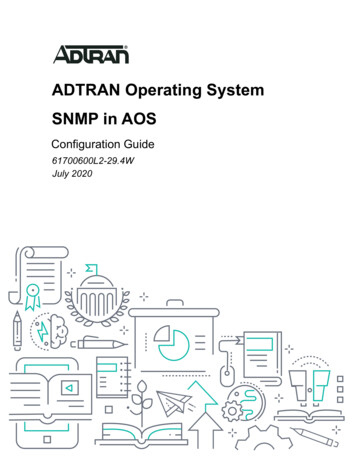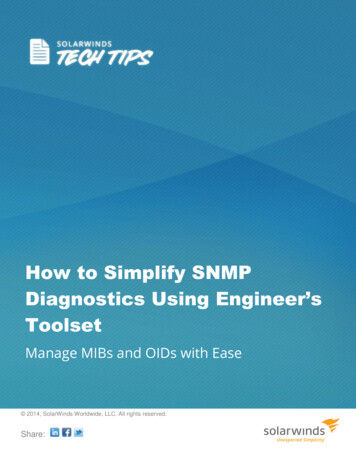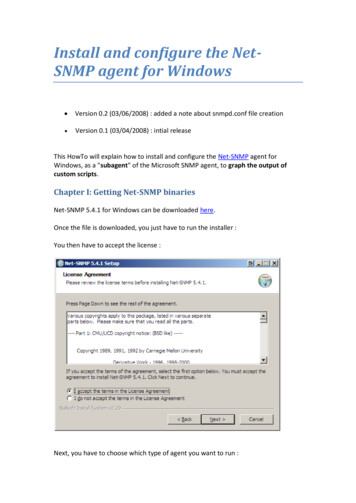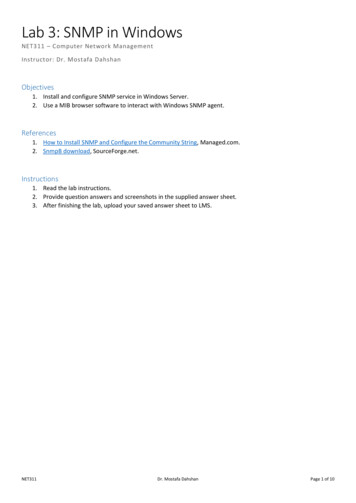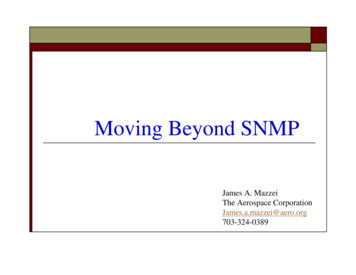
Transcription
Moving Beyond SNMPJames A. MazzeiThe Aerospace CorporationJames.a.mazzei@aero.org703-324-0389
Overview: GIG Network Management Introduction State of the Network(s)Steps Being TakenITIL & PBNMRecommendationsConclusions
Introduction Requirements for DOD Networks Include: A Integrated transport infrastructure Fully distributed information processing any source to destination Management of legacy command, control, communications, computers,intelligence, surveillance and reconnaissance data. DISA Business Operations & Systems and new MILSATCOM andfiber communications capabilitiesThe Global Information Grid (GIG) can be characterized as: A compilation of loose confederation of sometimes-networkedelements lacking central authority, oversight or guidance Dramatic movement to packet communications and convergent servicesthat require a more comprehensive and cohesive management system A network of networks that must accommodate the requirement fornear real-time control and the automation associated with Net-Centricwarfare.
State of the Network(s) The GIG is more aptly characterized as a Global Network InformationEnvironment.DOD Command and Control capabilities in state of flux and are trying tocoalesce The GIG grew as a variety of systems using a multiplicity of technicalbaselines and protocols to satisfy a group of dissimilar functions. The current environment not only doesn't facilitate Net-Centric Warfareit inhibits it. Concurrently, Network Operations (NetOps) is working to bring NetCentric Warfare into the infrastructure by ensuring the collaborativeoperation and management of the GIG by Combatant Commands,Services and Agencies (C/S/A) so that an integrated, seamless end-toend management structure can optimize the GIG transport capability. An evolutionary net-centric GIG management and operations strategyis gaining acceptance-maybe good, maybe not.
Mapping Process from IP through WDMIPIEEE 802.2 LLCRPRMACRPRPHYIEEE 802.2 LLCEthernet MAC10GigE10GigELAN PHY WAN PHYAAL 5PPPHDLCATMPOSGigEPHYGFPSONET/SDHInterface for OTN, G.709WDM, WWDM, DWDMOptical fiber/OTN (WDM)
Mapping Process from IP through WDMAcronyms: RPR Resilient Packet Ring, IEEE 802.17HDLC High-level Data Link ControlPOS Packet over SONET/SDHGFP Generic Framing Procedure (ANSI T1 X1 drivenstandard)OTN Optical Transport NetworkWDM Wavelength Division MultiplexingWWDM Wide WDMDWDM Dense WDM
State of the Network(s) (Complexity) Different functions and the different levels at which they are applied to differentcommunications media.IPOSI SONET ATM ATMlayer layer layerlayer sublyrFunctionalityCSProviding the standard interface3/4AAL SAR Segmentation and reassembly432/32Flow ControlCell header generation/extractionVirtual Ckt path managementCell multiplexing/demultiplexingATMTC2Phys11PMDCell rate decoupling Cell generationHeader, Checksum & Frame generationPacking/Unpacking cells from enclosing envelopeBit timing and physical network access
DoD Taking Steps to a Central Authority Status and resource reporting standards and automated reportingcapabilities to enhance decision making at all levels (DC top down) Manual reporting and posting of status information, although currentlynecessary, is not sufficient for more future oriented goals of automatedreporting capabilities First create an agreement or a standard as a necessary condition toreport and post status information useful for Enterprise ServiceManagement/Network Management (ESM/NM) Implementation Level (COCOM top down) Joint Task Force (JTF) networks, because of their remoteness and highlydynamic nature do not integrate now with DISN infrastructure. For command and control involving mobile war fighters, it should berelatively easy to develop a consensus that planning, situationalawareness and common operational picture development are the threeareas where standards and automated reporting are critical.
INMS and JNMSN e tO p s C e n te rD IS NIn te g ra te d N e tw o rk M a n a g e m e n t S y s te mJ o in t N e tw o rk M a n a g e m e n t S y s te mTELEPORTM a n a g e m e n t I n f o rm a t io nB a s e s ( in t e r c o n n e c t e d w it hr o u t e r s a n d s w it c h e s )S e rv ic eM anagem ent
INMS &Two Strategies Have BeenSuggested (INMS) Integrated Network Management System The First step toward DOD wide network Management INMS contains and expanding the use of SNMP The GIG Network(ITIL) IT Infrastructure Library ITIL is a best practice framework initially developed in the UK and primarilydistributed in Europe(PBNM) Policy Based Network Management PBNM is a holistic policy based management structure in which the policy isrepresented as a set of classes and relationships that define the semantics ofthe network building blocks. The semantics usually consist of a minimum Policy RulePolicy Condition Policy Action
The Information Technology InfrastructureLibrary (ITIL) Fundamentally, a service management view of network management thatdifferentiates itself from component management.IT IL A d v a n ta g e s A d o p t e d b y T iv o li, H P , C o m p u t e r A s s o c ia t e s( R e m e d y ) , B M C S o f t w a r e , M e r c u r y I n t e r a c t iv e& o th e rsI s b a s e lin e f o r M ic r o s o f t ’s M ic r o s o f t O p e r a t io n sF ra m e w o rk (M O F )I n f o r m a t io n a b o u t a ll n e t w o r k d e v ic e s isb r o u g h t in t o a c o m m o n d a t a b a s e c a lle d t h eC o n f ig u r a t io n M a n a g e m e n t D a t a b a s e ( C M D B )I S O is lo o k in g a t c r e a t in g a s p e c if ic a t io n b a s e do n IT IL
The Information Technology InfrastructureLibrary (ITIL) This service management approach also has one substantialdisadvantage. No standard means of populating the CMDBAnother potential problem exists in that ITIL is incompatible withSNMP. Therefore, a strategy where management networks graduallyevolve into an ITIL framework isn’t realistic.SNMP is built on the assumption that it’s independent of surroundingprotocols and can’t easily adapt to new devices. It’s also built arounda 448 byte message, limiting the size of an individual transaction.Finally, the IETF plans to replace the Command Line Interfaces(CLIs) and Web Interfaces with a standard configuration protocol.That protocol would encode configuration information as XMLdocuments and provide basic operations to upload Fundamental, high expense issue involved
(ITIL) Similar but not the gementUsername: string 1Employee: string 2Manager: string 3Trouble TicketManagementUsername: alpha numericEmployee: integerIsAdmin: Boolean
ITIL’s Brighter Side Conversion to ITIL can be facilitated by using the ITIL toolkit ITIL Toolkit Web Page. The toolkit includes: A detailed guide to ITIL and service management The ITIL fact sheets, which are 12 two page documents, serving as a concise summary of each of the ITIL disciplines A management presentation, inclusive of speaker notes An ITIL audit/review questionnaire and reporting set, based on MS-Exel Materials to assist in the reporting of the above results (e.g., presentationtemplate.)
PBNM CONCEPT Policy Based Network Management (PBNM) is, at its essence, the use ofrules to accomplish management decisions.The policy is represented as a set of classes and relationships that define thesemantics of the building blocks.The building blocks, in turn, usually consist of a minimum of a policy rule,a policy condition and a policy actionPolicy ConditionHas ConditionsPolicy RulePolicy ActionHas actions
Policy Based Network Management is a . Abstraction translation mechanism Define goals not device configurations Changes in policy lead to changes goals not implementations PBNM is a condition action response mechanism Provide an automatic response to conditions in the network according topre-defined policies
PBNM continued.The Directory Enabled Networks-new generation (DEN-ng) policy managementsystem takes the policy set shown below and triggers it with a policy event setP o lic y C o n d itio nP o lic y R u leP o lic y A c tio nP o licy A ctio n In P o licy R u leP o licy C o n d itio n In P o licy R u leIs T rig g ered B yP o lic y E v e n t S e t
Current Efforts Abstract the best features of ITIL and PBNM and and remove them fromthe transport layer considerationsYou therefore have all the advantages of both ITIL and PBNMYou therefore have all the costs of both ITIL and PBNM
Long Term Management Solution, SLA’s The long term solution to effective management is similar to the near term, althoughwith more specificity and therefore more complexity. The solution has two parts. First, gradually develop interfaces between networks and managementsystems. Second, negotiate service level agreements (SLAs) between DISNmanagers, JTF managers and managers of other tactical networks. Thenegotiating of these SLAs involves multiple levels of understanding, since theindividuals involved must:9 Recognize the unique nature of each system and each interface9Agree on commonality for status reporting9Develop a management language so the management process can beabstracted from the network
Long Term Management Solution, SLA’s The SLAs, in order to be warfighter focused, should give priority to latency,availability and throughput (or packet delivery) and might best be segregatedinto three different categories: Packet networks Switched circuit networks Optical networks. Common elements, examples of which might be: Introduction, including parties, dates and specific elements of networkscovered Problem management, configuration management, accountingmanagement and security management (FCAPS) Compensation, to include fees and penalties Provider and customer duties and responsibilities
Long Term Management Solution, SLA’s The packet network SLA would include items such as: NIPRNET and SIPRNET interface control documents Internet “bandwidth” to include maximum and minimum data rates,committed average data rate and burst size Expansion over codec rate for VoIP Jitter, packet loss and other performance parametersThe switched circuit SLA: User-to-user latency User-to-user availability Identification of maximum possible data rates using Shannon andNyquist characterizations Identification of other performance parameters and measurementtechniques used
Long Term Management Solution, SLA’s The optical circuit SLA: Identification of the specific layering used from data to fiber Identification of the processes used including optical to electricalconversions Bandwidth used vs. bandwidth available Identification of other performance parameters and measurementtechniques used
Conclusion DoD network management is fragmented, an SNMP quick fix could beimplemented with a minimum of strain. In the longer term ITIL offers promise, although a possibly expensivecommon database is an essential ingredient. PBNM is another system of promise, although a possibly expensivecommon information language or middleware is necessary. Some have suggested that a combination of the two systems will evolve.That may be possible, but that would be a most expensive option. Hopefully, DoD executive management will make and enforce a choice ofan intermediate step.
Adopted by Tivoli, HP, Computer Associates (Rem edy), BM C Softw are, M ercury Interactive & others Is baseline for Microsoft’s Microsoft Operations Framework (MOF) Inform ation about all netw ork devices is brought into a common database called the Configuration Management Database (CMDB
